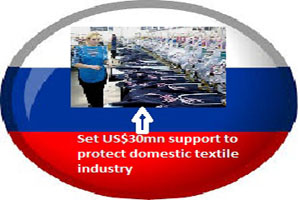
Russian govt sets US$30mn support to protect domestic textile industry
YarnsandFibers News Bureau 2016-05-06 17:00:00 – UKThe Russian government to protect the domestic textile industry against foreign competition has approved a proposed programme under an existing government policy know as the “Strategy of development of textile and light industry in the Russian Federation for the period till 2025†which includes covering the current financial year.
The volume of support has been set by the ministry of industry and trade at two billion roubles (US$30m).
As for the latest spending programme, the government has confirmed that the majority of allocated funds will be spent on direct subsidies for textile and clothing manufacturers, especially producers of specialist technical clothing and school uniforms.
A portion of these funds will cover interest rates on loans, borrowed by Russian manufacturers from banks. Also, as mooted by earlier Russian government discussions, some of the funds will be spent on establishing a special bank branch within the state-run Russian Agricultural Bank (Rosselkhozbank), which will focus on providing loans to local clothing and textile manufacturers on beneficial terms.
The government also plans to provide funds for technical support and re-equipping manufacturers with a new plant. And another tranche of the finds will be invested in training skilled personnel within the industry.
According to an official spokesman for Denis Manturov, Russia’s minister of industry and trade responsible for the development of textile and light industry in the Russian government, believes a lack of skilled personnel is restricting growth within the Russian textile industry.
The collapse of the USSR and the series of economic and political crises in Russia have resulted in a significant decline of demand for work in the domestic textile industry from college graduates, that became mainly due to low wages, offered by the industry, which are significantly lower than those offered by other industries of Russian industrial production.
Due to this, a shortage of skilled personnel (along with the traditional shortage of raw materials and poor technical equipment) has become one of the most pressing problems of the industry.
Ministry documents released when the spending announcement was made argue that training is especially important, given over the past two years the number of job vacancies in the Russian textile sector has increased by almost 30% and continues to grow, along with salaries of the industry’s workers.
Andrey Razbrodin, president of the Russian Union of Entrepreneurs of Textile and Light Industry (Soyzlegprom), said that the adoption of the programme is a good news for the industry, however much will depend on the rates of its further implementation. Lack of cheap loans currently remains one of the most pressing problems for the industry, as the present policy of the majority of banks aimed at reducing their loan portfolios. However, the establishment of a branch bank within the structure of Rosselkhozbank may help to solve this problem.
The spending announcement has been made as the government expands a ban on federal government ministries and agencies on purchasing foreign-made textile products to regional and municipal authorities, who must henceforth source clothing and textile supplies in Russia.
At present, Russian-made textile product’s share within the domestic market is estimated at 24.6%, according to Russia’s ministry of industry and trade. However, the Russian government wants to increase this proportion to 50% by 2018-2019. This expansion will also generate up to 100,000 new jobs within the industry.
Market Intelligence
Ask for free sample Report

experience
Customer Base
dedicated team
Countries Served Worldwide









